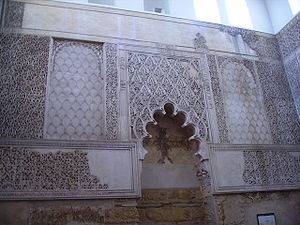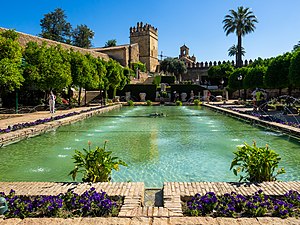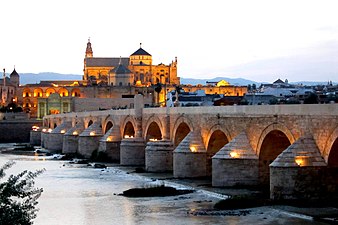
Córdoba, Spain
Córdoba (/ˈkɔːrdəbə/ KOR-də-bə, Spanish: [ˈkoɾðoβa] ), or sometimes Cordova (/ˈkɔːrdəvə/ KOR-də-və),[6] is a city in Andalusia, Spain, and the capital of the province of Córdoba. It is the third most populated municipality in Andalusia.
The city primarily lies on the right bank of the Guadalquivir in the south of the Iberian Peninsula. Once a Roman colonia, it was taken over by the Visigothic Kingdom followed by the Muslim conquest in the eighth century. Córdoba became the capital of the Caliphate of Córdoba, from which the Umayyad dynasty ruled all of al-Andalus until 1031. Under Umayyad rule, Córdoba was transformed into a world-leading center of education and learning,[7][8] and by the 10th century it had grown to be the second-largest city in Europe.[9][10]
Al-Andalus experienced a manyfold political crisis in the early 11th century that brought about state collapse. Following the Christian conquest in 1236, it became part of the Crown of Castile as the head of the Kingdom of Córdoba.
Córdoba is home to notable examples of Moorish architecture such as the Mezquita-Catedral, which was named as a UNESCO World Heritage Site in 1984 and is now a cathedral. The site has since been expanded to encompass the whole historic centre of Córdoba. Madinat al-Zahra near the city is also a World Heritage Site while the Festival de los Patios has been recognized as UNESCO Intangible Cultural Heritage.
Córdoba has the highest summer temperatures in Spain and Europe, with average high temperatures around 37 °C (99 °F) in July and August.[11] Summers are very dry whereas the mild winters have frequent rainfall.
Etymology[edit]
The name Córdoba has attracted fanciful explanations. One theory, suggested in 1799 by José Antonio Conde, is that the name comes from Punic qart ṭūbah "good town" as Córdoba was founded during Carthaginian Iberia. After the Roman conquest, the town's name was Latinised as Corduba.[12] During the era of Muslim rule the city was known in Arabic as Qurṭubah (Arabic: قرطبة).[13]
Tourism is especially intense in Córdoba during May as this month hosts three of the most important annual festivals in the city:[135]
Transport[edit]
Rail[edit]
Córdoba railway station is connected by high speed trains to the following Spanish cities: Madrid, Barcelona, Seville, Málaga and Zaragoza. More than 20 trains per day connect the downtown area, in 54 minutes, with Málaga María Zambrano station, which provides interchange capability to destinations along the Costa del Sol, including Málaga Airport.
Airports[edit]
Córdoba has an airport, although there are no airlines operating commercial flights on it. The closest airports to the city are Seville Airport (110 km as the crow flies), Granada Airport (118 km) and Málaga Airport (136 km).[146][147]


![(Christian) Capilla de San Bartolomé (c. 1410[148])](http://upload.wikimedia.org/wikipedia/commons/thumb/4/40/Capilla_Mud%C3%A9jar_de_San_Bartolom%C3%A9_in_der_Calle_Averroes%2C_C%C3%B3rdoba_-_panoramio.jpg/383px-Capilla_Mud%C3%A9jar_de_San_Bartolom%C3%A9_in_der_Calle_Averroes%2C_C%C3%B3rdoba_-_panoramio.jpg)








![Statue of Seneca the Younger by the Puerta de Almodóvar [es]](http://upload.wikimedia.org/wikipedia/commons/thumb/0/0b/Seneca_at_the_Puerta_de_Almod%C3%B3var_-_C%C3%B3rdoba%2C_Spain_-_DSC07075.JPG/357px-Seneca_at_the_Puerta_de_Almod%C3%B3var_-_C%C3%B3rdoba%2C_Spain_-_DSC07075.JPG)